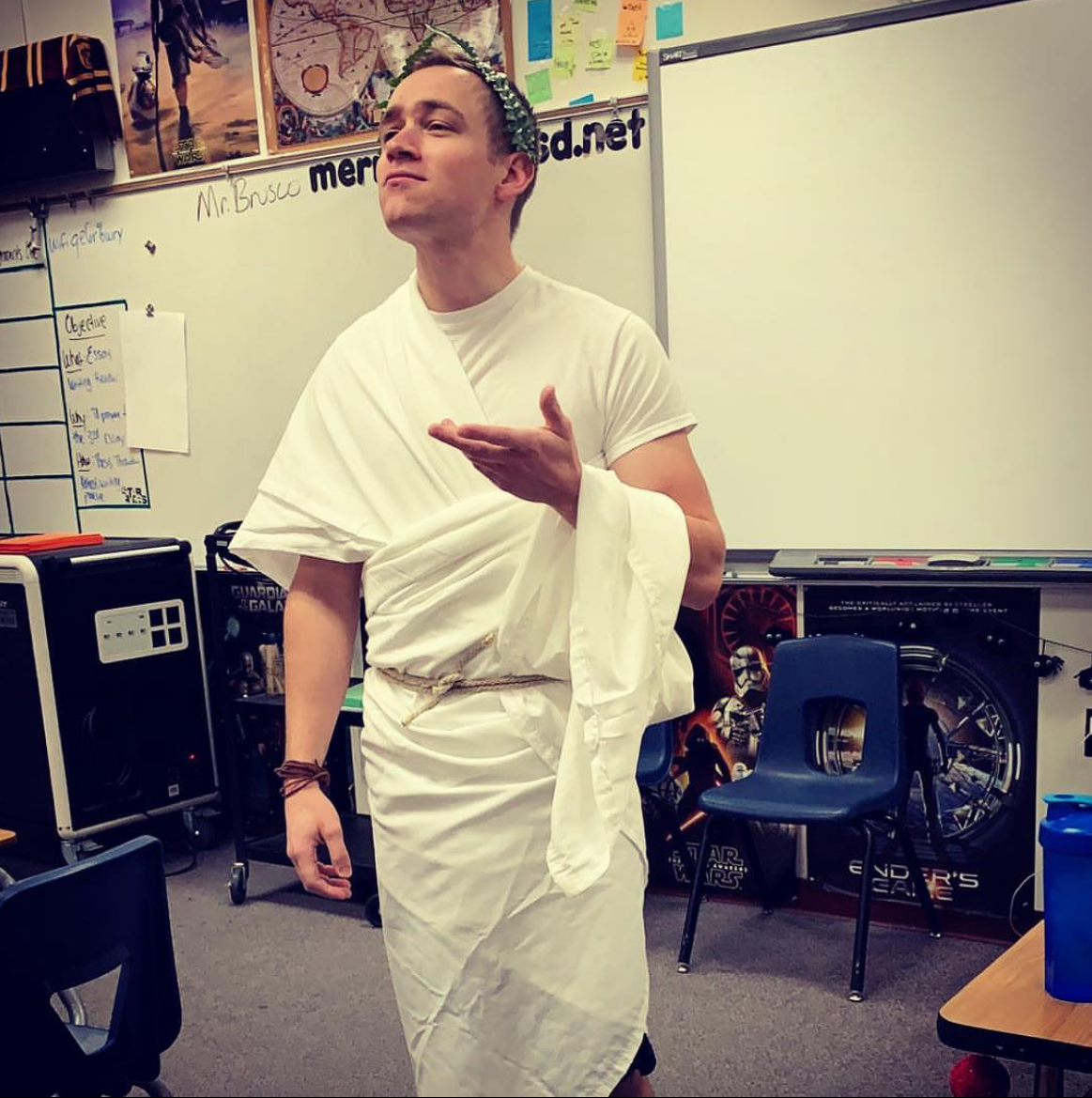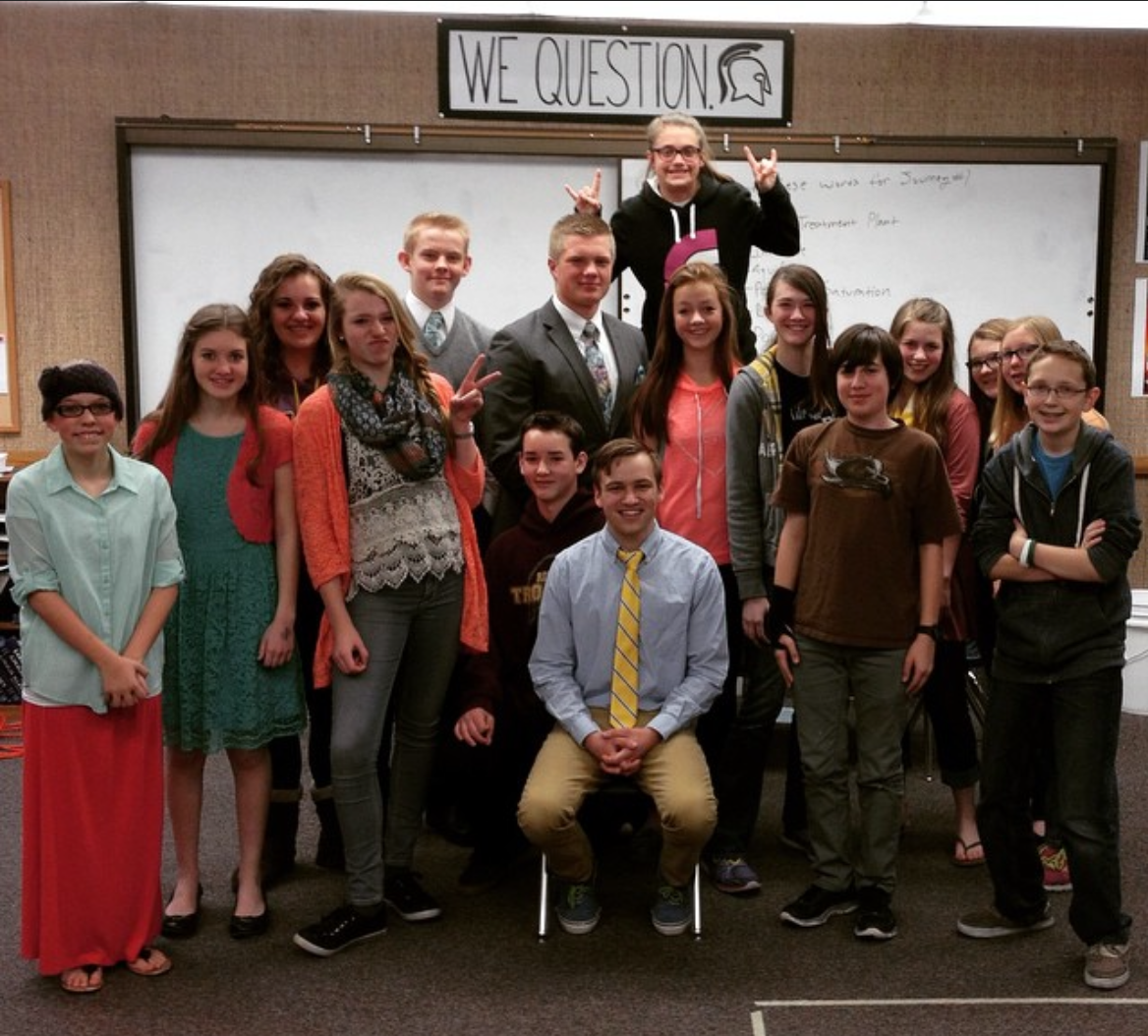Dressed up for my ELA Mythology Unit
Mr. Brusco
I’m a passionate educator whose emphasis on agency, mutual respect, and shared responsibility empowers students to become the drivers of their own learning. My teaching philosophy is greatly informed by Abraham Maslow’s Hierarchy of Needs. If the ultimate goal of education is to help students reach autonomy—at the top of Maslow’s hierarchy—then classroom conditions must first meet those foundational needs that precede self-actualization. These prerequisites include physical safety and belonging. The latter is especially important for young learners.
But how can a teacher foster a sense of belonging in their classrooms? By building community. This is where guiding principles like mutual respect and shared responsibility come into play. A safe learning environment is founded on respect and ensures everyone has a role to play and feels valued. This allows students to exchange ideas without fear of judgement or ridicule. They can give themselves wholeheartedly to a task and let their curiosities guide them without worrying about failure.
In short, this kind of learning environment engenders what Dr. Carol Dweck calls a growth mindset.
Philosophy
My pedagogy leans heavily on personal application, scaffolding, and generative topics. One of my favorite parts about teaching is coming up with creative activities that have students engage in embodied learning where they get to use their senses, not just their minds. When prepping for instruction, I reflect on how the subject is personally applicable to my students. External motivators, like grades or pizza parties, never lead to deep learning or mastery. To climb to those kinds of heights requires students to be intrinsically motivated—meaning they not only understand why they’re climbing, but have their own reasons to do so. This means helping link what’s authentic and interesting to them with what we’re doing in the classroom. Always explicit in my teaching is an effort to engage those intrinsic passions and curiosities of my students.
In addition to the what and why, I also take into consideration the how when it comes to designing curriculum. I refer to Howard Gardner’s theory of Multiple Intelligences as a framework for appreciating how each student learns differently and are at different levels, and I aim to differentiate my instruction accordingly. For instance, when I was leading 8th-graders through an Astronomy unit, we had just finished a lesson on the earth’s axis and why we experience seasons. To demonstrate understanding, students could either deliver a written explanation of how the earth’s axis affects the seasons, draw and label a diagram, or they could come and show me what Spring, Summer, Fall, or Winter looks like by positioning a globe near a basketball (which was our sun).
I’m also a firm believer in scaffold learning, which means I look for the small steps we can take toward a learning objective instead of insisting students take a big leap in their understanding. This is closely linked to how I like to incorporate generative topics in the class. Generative topics are big ideas, questions, or themes that we can draw upon throughout a unit. For instance, as an 8th-grade science teacher, we used journey as our generative topic for our unit on the water cycle. We learned that a journey isn’t just going from A to B, but experiencing a process of change along the way.
Pedagogy
Me pictured with one of my 8th-grade classes at Rigby Middle School
I’ve taught Math, Science, and Art to K - 8th-graders in an outdoor setting at the Teton Range in ID, four classes of 8th-grade Science in Rigby, ID, and 9th- and 12th-grade English Language Arts + a Speech and Debate course in Las Vegas, NV.
While pursuing my education degree in Rexburg, Idaho, I had the opportunity to join a new program called Professional Semester. The practicum combined several introductory and upper-level education courses into a single semester and required us to lead classes every Tuesday and Thursday at an outdoor learning center near the Tetons. I was one of four students to enroll. As a 22-year-old who had only decided the previous semester that he wanted to become an English Language Arts (ELA) teacher, the experience was indelible. By teaching multiple topics, like math, art, and science, to varying age groups in an outdoor setting, I learned firsthand how teaching is a craft and discipline all of its own; that a skilled educator can teach anything to anyone.
Having excelled in the program, I was selected for another rare opportunity the following semester: teaching four periods of 8th-grade science at a middle school in Rigby, Idaho. This was a daunting proposition for me. I was studying to teach ELA, what business did I have leading units on Astronomy or the water cycle? It was a crash course in multiple arenas, but I learned so much and still treasure the ukulele case all my students signed when my allotted time with them concluded. What’s more, through my university’s partnership with the middle school where I taught, I was required to supervise other university students as they led lessons with my kids and provide feedback afterward.
A strength of mine that surfaced during my four months as a science teacher was instructional design. I discovered I had a knack for thinking outside the box when it came to how we experienced and explored subjects. For instance, our Astronomy unit culminated in students working in groups to create a planetary cookbook, where they wrote recipes for how to “bake” a Jovian or Terrestrial planet. At the end of our water cycle unit, my students and I co-created a fun outdoor activity inspired by Red Light, Green Light, where students acted like water molecules and performed different tasks depending on whether they were evaporating, condensing, or precipitating.
This strength helped me during my time as a teacher at a Title I school in Las Vegas, Nevada, where I student-taught a freshman ELA class. When a full-time position unexpectedly opened mid-year, I was the top candidate to fill it. I began the year as a student teacher leading ninth graders in a mythology unit, and ended it as a full-time 12th-grade teacher guiding soon-to-be graduates through Gothic literature and Transcendentalism.
Background
Highlights from Letters of Recommendation | Letters available upon request!
“As I worked with Bo, I saw that he had a spectacular flare for creating engaging and creative curriculum. During his student teaching, Mr. Brusco created a month long unit that focused on mythology and culture. The unit he created encouraged students to interact with each other, gain a solid understanding of the curriculum, and develop deeper critical thinking skills. Students flourished during Mr. Brusco's unit and have shown great academic development because of his engaging instruction. While Bo was teaching, students were excited to learn because they were interested in the curriculum and Mr. Brusco created a safe and enriching class culture.” - Jana Innes, Mentor Teacher | Las Vegas High School.
“Bo collaborates within his grade level, sharing innovative teaching strategies and ideas, and uses his strengths of organization and curriculum development to enhance effectiveness as a team. He is a good listener and considers many different viewpoints when making decisions. His mindset that all students can achieve is contagious within the department and creates a sense of optimism throughout the school. His knowledge of how students learn along with his ability to effectively utilize adult teaching principles make him an excellent asset to the teachers at our school.” - Phongsavanh Skvarek, Assistant Principal | LasVegas High School.
“One of the first things I noticed about Mr.Brusco was the high expectations he had for his students and the positive way in which they responded to these expectations. He was respectful of them and they in turn, listened, participated, experimented, and grew in their knowledge. He has a strong rapport with his students.” - Diana Wilson, Mentor Teacher | Rigby Middle School.

